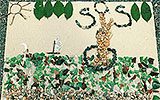Phosphorus
Phosphorus is one of the key nutrients affecting the ecosystems of the Danube River Basin and the Black Sea, by exacerbating eutrophication.
The total phosphorus load in the Danube River is around 48,900 tonnes per annum (1992-1996). This phosphorus mainly originates from sources such as wastewater discharges and erosion of fertilised farmland.
Diagram: Sources of phosphorus emissions into the Danube (1998-2000)
Product controls
Products used in households and industry and transferred to water cause pollution of the water they are blended with. For instance, polyphosphate-containing detergents (used in households for laundry purposes) act this way. Before poly-phosphate free detergents were introduced in Austria in the middle of the 1980s around half of the load of phosphorus in untreated wastewater originated from this source.
The ICPDR report "Removal of Phosphates from Detergents in the Danube Basin" gives clear recommendations as to how discharges of phosphorus into the water-bodies can be minimised. One of the conclusions of the report is that phosphate-free detergents can significantly reduce phosphate loads in surface waters.
According to the experience of western European states, where phosphate-free detergents are already widely used, the overall cost of introducing phosphate-free detergents is much less than the additional cost of improving sewage treatment to eliminate more phosphates. The introduction of phosphate-free detergents does not involve any additional cost to consumers or governments.
The ICPDR is taking the initiative by approaching the detergent industry to obtain commitments to promote the use of phosphate-free detergents in the Danube River Basin. This can be done using economic instruments or voluntary agreements.
Inventory of diffuse Sources of Nitrogen and Phosphorus
Environmental Research of the Federal Ministry of the Environment, Nature Conservation and Nuclear Safety Water Research Project Research Report 200 22 232 Harmonised Inventory of Point and Diffuse Emissions of Nitrogen and Phosphorus for a Transboundary River Basin
Fulltext (PDF, 6.1MB)Disclaimer
The information contained in the ICPDR website is intended to enhance public access to information about the ICPDR and the Danube River. The information is correct to the best of the knowledge of the ICPDR Secretariat. If errors are brought to our attention we will try to correct them.
The ICPDR, expert group members, nor other parties involved in preparation of information contained on this website cannot, however, be held responsible for the correctness and validity of the data and information provided, nor accept responsibility or liability for damages or losses arising directly or indirectly from the use of the information conveyed therein.
Only those documents clearly marked ICPDR documents reflect the position of the ICPDR.
Any links to other websites are provided for your convenience only. The ICPDR does not accept any responsibility for the accuracy, availability, or appropriateness to the user's purposes, of any information or services on any other website.
When using the information and material provided on this website, credit should be given to the ICPDR.

